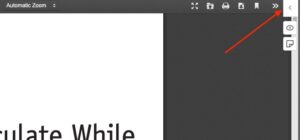This page contains PDFs of the course readings (for Prof. Pitet’s Monday/Wednesday 9:30am section). We will use these for our group annotation practice in critical reading.
Click the title of a reading to go to a PDF with the hypothes.is annotation tool built in (no browser plugin necessary, but you’ll need a hypothes.is account).
To make annotations: Once you’re viewing the PDF, click the tab at the top right to expand the hypothes.is annotation pane. 
Log in if necessary. 
October 7
- Alim, H. Samy, and Geneva Smitherman. 2012. “‘Nah, We Straight’: Black Language and America’s First Black President.” In Articulate While Black: Barack Obama, Language, and Race in the U.S., 1–30. Oxford: Oxford University Press.
In-class exercise:
Select one example the authors use (e.g., Ben’s Chili Bowl, the White House correspondent’s dinner).Highlight a small portion of the text and create an annotation.Briefly describe what’s going on and what the authors say about it, in your own words.Include a link to the Youtube video or some other online source that illustrates this. Don’t just paste the link into your annotation; use the link icon to hyperlink some text from your annotation.Format some text in your annotation as bold or italic.Find a relevant image and add it to your annotation.Extra credit: identify some place in the text where the authors themselves use the style or language feature they’re analyzing.
Hint: use the Preview feature to preview what your annotation will look like before you post it.
October 14
- Hill, Jane H. 1999. “Language, Race, and White Public Space.” American Anthropologist 100 (3): 680–89.
Class exercise: what’s the point?
In small groups, discuss what you think the main point of this article is. When your group has come to a consensus, write one or two clear, concise sentences (in your own words) that paraphrase the article’s main point.Highlight a short passage in the text where the author gives evidence to support the main point, then create a Hypothesis annotation.Type your paraphrase of the main point in the annotation text box.Write two or three more sentences describing why you think the highlighted text provides evidence of the main point.
October 21
- Blommaert, Jan. 2009. “Language, Asylum, and the National Order.” Current Anthropology 50 (4): 415–41.
Class exercise: summarizing evidence
See the section “Modernist Responses” in the reading. I’ve created an annotation where the author, Blommaert, indicates that what he is about to do is “observe how…governments appear to formulate…modernist responses” to “postmodern realities” (424).Each group should create a new annotation in that section. Highlight a few sentences in which Blommaert describes how the evidence he has given above is an example of a “postmodern response.”In the text of your annotation, paraphrase what Blommaert is describing.Your paraphrase might benefit from defining one or more key terms or phrases—for example, linguistic repertoire, sociolinguistic profile, monoglot ideology, linguistic community, speech community.
October 28
- Gaudio, Rudolph P. 2003. “Coffeetalk: StarbucksTM and the Commercialization of Casual Conversation.” Language in Society 32 (5): 659–91.
- Gershon, Ilana. 2016. “‘I’m Not a Businessman, I’m a Business, Man’: Typing the Neoliberal Self into a Branded Existence.” HAU: Journal of Ethnographic Theory 6 (3): 223–46.
November 4
- Irvine, Judith T. 1989. “When Talk Isn’t Cheap: Language and Political Economy.” American Ethnologist 16 (2): 248–67.
- Coombe, Rosemary J. 2016. “The Knowledge Economy and Its Cultures: Neoliberal Technologies and Latin American Reterritorializations.” HAU: Journal of Ethnographic Theory 6 (3): 247–75.
November 11
- Shipton, Parker. 2003. “Legalism and Loyalism: European, African, and Human ‘Rights.’” In At the Risk of Being Heard: Identity, Indigenous Rights, and Postcolonial States, edited by Bartholomew Dean and Jerome M. Levi, 45–79. Ann Arbor: University of Michigan Press.
Class exercise: parsing language
In groups, assign one person who has web access and a Hypothesis account to be the group’s “scribe”. Go to this article by David Graeber and find my Hypothesis annotation.“Parse” these sentences by carefully reading them and paraphrasing them in your own language. Pay special attention to how Graeber is “defining” what “direct juro-political extraction” is by using it in the first sentence and then elaborating in the second sentence.Reply to my annotation with your paraphrase of the sentence and your guess at the definition of “juro-political” based on your paraphrase.
November 18
- Derrida, Jacques. 1986. “Declarations of Independence.” New Political Science 7 (1): 7–15.
- Siskind, Janet. 2002. “The Invention of Thanksgiving: A Ritual of American Nationality.” In Food in the USA: A Reader, edited by Carole Counihan, 41–58. New York: Routledge.
December 2
- Avineri, Netta, Eric Johnson, Shirley Brice-Heath, Teresa McCarty, Elinor Ochs, Tamar Kremer-Sadlik, Susan Blum, et al. 2015. “Invited Forum: Bridging the ‘Language Gap.’” Journal of Linguistic Anthropology 25 (1): 66–86.
- Hermes, Mary, and Chad Uran. 2006. “Treaties That Dominate and Literacy That Empowers? I Wish It Was All in Ojibwemowin.” Anthropology & Education Quarterly 37 (4): 393–98.

